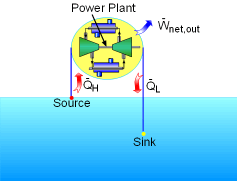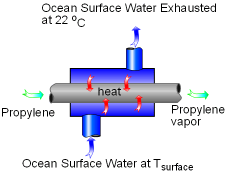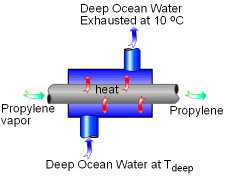| Ch 5. Second Law of Thermodynamics | Multimedia Engineering Thermodynamics | ||||||
| Heat Engine |
The Second Law |
Carnot Cycle |
Carnot Heat Engine |
Carnot Refrigerator |
|||
| Heat Engine | Case Intro | Theory | Case Solution |
| Chapter |
| 1. Basics |
| 2. Pure Substances |
| 3. First Law |
| 4. Energy Analysis |
| 5. Second Law |
| 6. Entropy |
| 7. Exergy Analysis |
| 8. Gas Power Cyc |
| 9. Brayton Cycle |
| 10. Rankine Cycle |
| Appendix |
| Basic Math |
| Units |
| Thermo Tables |
| eBooks |
| Dynamics |
| Fluids |
| Math |
| Mechanics |
| Statics |
| Thermodynamics |
| ©Kurt Gramoll |
|
|
||
|
The volumetric flow rates of the ocean surface water and deep ocean water need to be determined for a new Ocean Thermal Energy Conversion (OTEC) power plant. Assumptions: Assume the ocean water has the same properties as pure water and is modeled as incompressible fluid. |
||
|
|
(1) Determine the heat transferred to the power plant from the surface
water ( To operate an OTEC power plant involves both a heat source and a heat sink. Therefore, the hot ocean surface water serves as the heat source and the cold deep ocean water serves as a heat sink. The power plant generates net work. Hence, it is a heat engine. The definition of thermal efficiency for a heat engine is where If the ηth is given as 5%, heat transferred from the heat source to the power plant is The energy balance of the power plant is Hence the heat transferred to the sink from the power plant is |
|
|
|
(2) Determine the volumetric flow rates of the ocean surface water and the deep ocean water The ocean surface water is sent to the evaporator (a heat exchanger) where the working fluid propylene vaporizes. Consider the ocean water in the heat exchanger as a system, the heat transfer between the ocean water and the propylene can be determined as: where ΔT is the temperature difference of the ocean water between the inlet and exit, which is ΔT = 27 - 22 = 5 oC Hence the volumetric flow
rate ( The deep ocean water is sent to the condenser (a heat exchanger) where the propylene vapor condenses to liquid. The flow rate of the deep ocean water can be determined using a similar way. That is, At 1,000 meter depth of the sea, the temperature of the water is Tdeep = -0.022 h + Tsurface The water leaves the condenser at 10 oC. Hence, the temperature increase of the deep ocean water is ΔT = 10 - 5 = 5 oC In heat exchangers, properties are determined using the average temperature at the inlet and exit. For the evaporator, the average temperature of the water is 24.5 oC.The density and the specific heat of water at that temperature are: ρsurface = 997 kg/m3 and cP,surface = 4.18 kJ/kg-oC Also, the average temperature for the condenser is 7.5 oC, the density and the specific heat of water are: ρdeep = 997.8 kg/m3 and cP,deep = 4.22 kJ/kg-oC Substituting all these numbers to the flow rate equations, the flow rates can be determined. They are: |
|



